warning SKODA SUPERB 2004 1.G / (B5/3U) Owner's Manual
[x] Cancel search | Manufacturer: SKODA, Model Year: 2004, Model line: SUPERB, Model: SKODA SUPERB 2004 1.G / (B5/3U)Pages: 270
Page 154 of 270
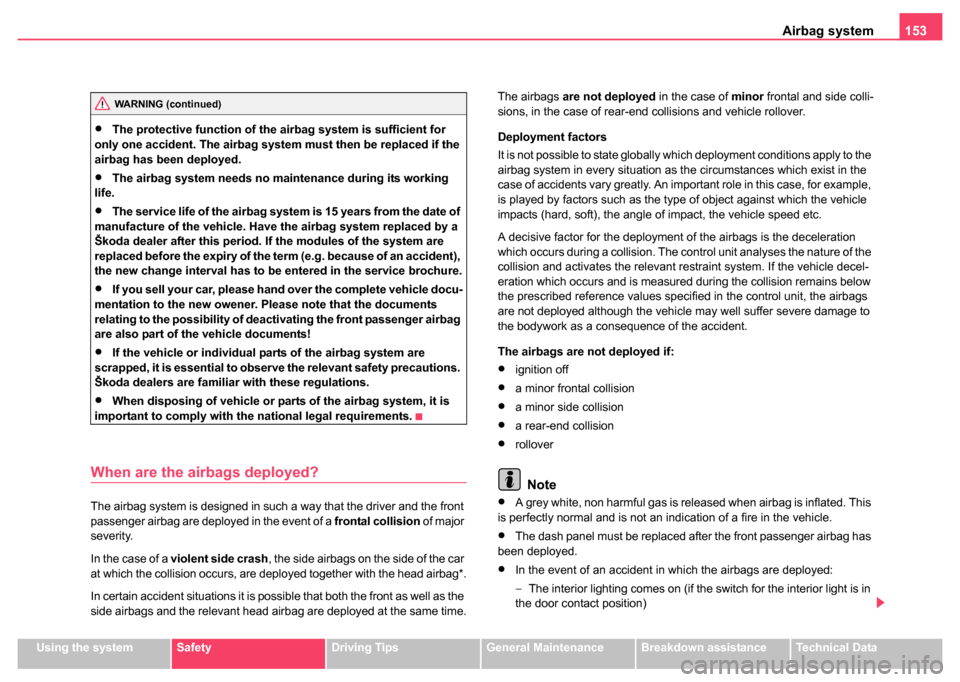
Airbag system153
Using the systemSafetyDriving TipsGeneral MaintenanceBreakdown assistanceTechnical Data
•The protective function of the airbag system is sufficient for
only one accident. The airbag system must then be replaced if the
airbag has been deployed.
•The airbag system needs no maintenance during its working
life.
•The service life of the airbag system is 15 years from the date of
manufacture of the vehicle. Have the airbag system replaced by a
Škoda dealer after this period. If the modules of the system are
replaced before the expiry of the term (e.g. because of an accident),
the new change interval has to be entered in the service brochure.
•If you sell your car, please hand over the complete vehicle docu-
mentation to the new owener. Please note that the documents
relating to the possibility of deactivating the front passenger airbag
are also part of the vehicle documents!
•If the vehicle or individual parts of the airbag system are
scrapped, it is essential to observe the relevant safety precautions.
Škoda dealers are familiar with these regulations.
•When disposing of vehicle or parts of the airbag system, it is
important to comply with th e national legal requirements.
When are the airbags deployed?
The airbag system is designed in such a way that the driver and the front
passenger airbag are deployed in the event of a frontal collision of major
severity.
In the case of a violent side crash , the side airbags on the side of the car
at which the collision occurs, are deployed together with the head airbag*.
In certain accident situations it is possible that both the front as well as the
side airbags and the relevant head airbag are deployed at the same time. The airbags
are not deployed in the case of minor frontal and side colli-
sions, in the case of rear-end collisions and vehicle rollover.
Deployment factors
It is not possible to state globally which deployment conditions apply to the
airbag system in every situation as the circumstances which exist in the
case of accidents vary greatly. An important role in this case, for example,
is played by factors such as the type of object against which the vehicle
impacts (hard, soft), the angle of impact, the vehicle speed etc.
A decisive factor for the deployment of the airbags is the deceleration
which occurs during a collision. The control unit analyses the nature of the
collision and activates the relevant restraint system. If the vehicle decel-
eration which occurs and is measured during the collision remains below
the prescribed reference values specified in the control unit, the airbags
are not deployed although the vehicle may well suffer severe damage to
the bodywork as a consequence of the accident.
The airbags are not deployed if:
•ignition off
•a minor frontal collision
•a minor side collision
•a rear-end collision
•rollover
Note
•A grey white, non harmful gas is released when airbag is inflated. This
is perfectly normal and is not an indication of a fire in the vehicle.
•The dash panel must be replaced after the front passenger airbag has
been deployed.
•In the event of an accident in which the airbags are deployed:
− The interior lighting comes on (if the switch for the interior light is in
the door contact position)
WARNING (continued)
Page 155 of 270
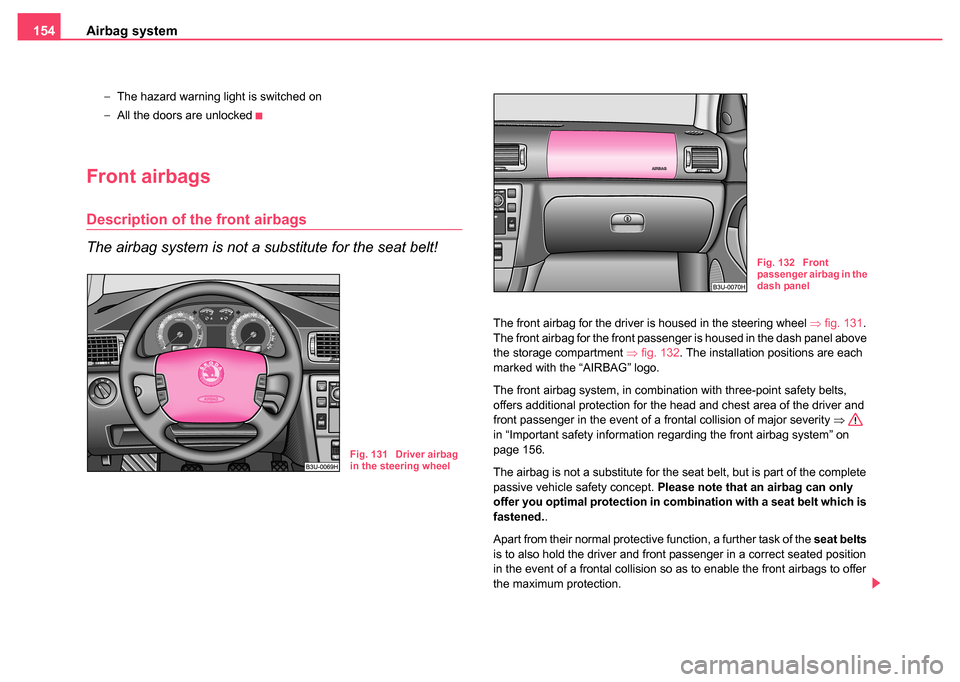
Airbag system
154
− The hazard warning light is switched on
− All the doors are unlocked
Front airbags
Description of the front airbags
The airbag system is not a substitute for the seat belt!
The front airbag for the driver is housed in the steering wheel ⇒fig. 131 .
The front airbag for the front passenger is housed in the dash panel above
the storage compartment ⇒fig. 132 . The installation positions are each
marked with the “AIRBAG” logo.
The front airbag system, in combination with three-point safety belts,
offers additional protection for the head and chest area of the driver and
front passenger in the event of a frontal collision of major severity ⇒
in “Important safety information regarding the front airbag system” on
page 156.
The airbag is not a substitute for the seat belt, but is part of the complete
passive vehicle safety concept. Please note that an airbag can only
offer you optimal protection in combination with a seat belt which is
fastened. .
Apart from their normal protective function, a further task of the seat belts
is to also hold the driver and front passenger in a correct seated position
in the event of a frontal collision so as to enable the front airbags to offer
the maximum protection.
Fig. 131 Driver airbag
in the steering wheel
Fig. 132 Front
passenger airbag in the
dash panel
Page 157 of 270

Airbag system
156
Important safety informat ion regarding the front
airbag system
Correct use of the airbag system considerably reduces the
risk of injury!
WARNING
•Never transport children on the front seat of a vehicle without
using a proper restraint system. If airbags are deployed in the event
of an accident, the child might suff er severe or even fatal injuries!
•For the driver and front passenger it is important to maintain a
distance of at least 25 cm from the steering wheel or dash panel
⇒ fig. 134 . Not maintaining this minimu m distance will mean that
the airbag system will not be able to properly protect you - hazard!
The front seats and the head restraints must always also be
correctly adjusted to match the body size of the occupant.
•It is essential to always switch off ⇒page 161, “Deactivating an
airbag” the front passenger airbag when attaching a child safety seat on the front passenger seat where the child is seated with its
back facing in direction of travel (in some countries also when the
child is facing the direction of travel). If this is not done, there is a
risk of the child suffering severe or
even fatal injuries if the front
passenger airbag is deployed. In certain countries national legal
provisions also require that the side or head passenger airbags be
deactivated. When transporting a child on the front passenger seat,
please comply with the appropriat e national regulations regarding
the use of child safety seats.
•There must not by any further persons, animals or objects posi-
tioned between the front seated occupants and the deployment
area of the airbag.
•The steering wheel and the surface of the airbag module in the
dash panel on the passenger side must not be stuck onto, covered
or modified in any other way. These parts should only be cleaned
with a dry cloth or a cloth moistened with water. No objects such
as cup holders, mobile phone mounts, etc. may be attached to the
covers of the airbag modules or be located within the immediate
area.
•No modifications of any kind may be made to parts of the airbag
system. Any work on the airbag system including installing and
removing system components because of other repair work (e.g.
removing the steering wheel) must only be carried out by a Škoda
dealer.
•Never carry out changes on the front bumper or on the body.
•Never place any objects on the surface of the front passenger
airbag in the dash panel.
Fig. 134 Safe distance
to steering wheel
WARNING (continued)
Page 159 of 270
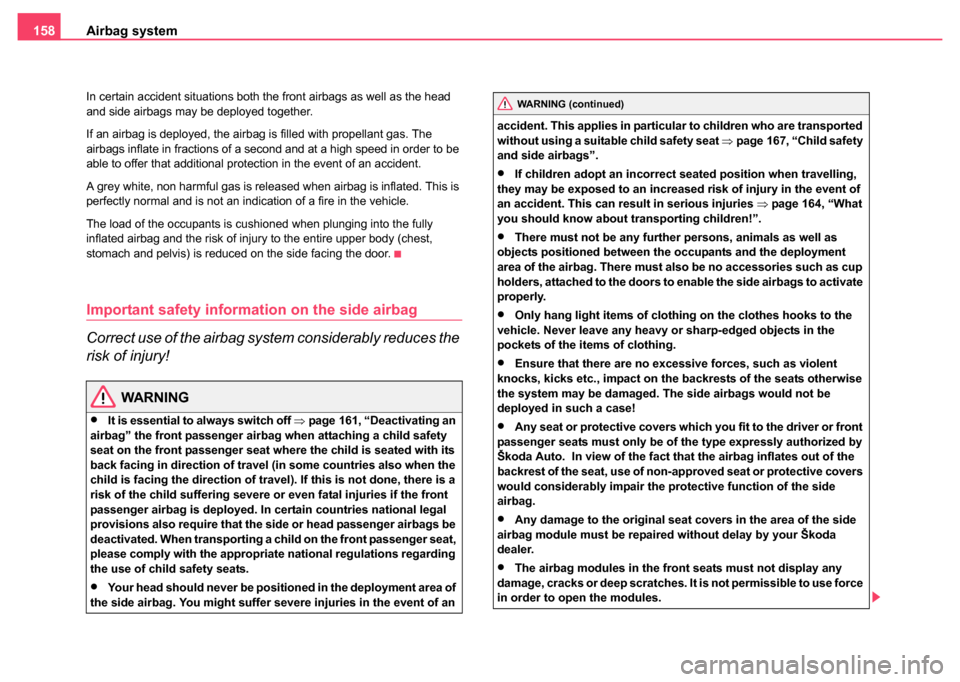
Airbag system
158
In certain accident situations both the front airbags as well as the head
and side airbags may be deployed together.
If an airbag is deployed, the airbag is filled with propellant gas. The
airbags inflate in fractions of a second and at a high speed in order to be
able to offer that additional protection in the event of an accident.
A grey white, non harmful gas is released when airbag is inflated. This is
perfectly normal and is not an indication of a fire in the vehicle.
The load of the occupants is cushioned when plunging into the fully
inflated airbag and the risk of injury to the entire upper body (chest,
stomach and pelvis) is reduced on the side facing the door.
Important safety information on the side airbag
Correct use of the airbag system considerably reduces the
risk of injury!
WARNING
•It is essential to always switch off ⇒page 161, “Deactivating an
airbag” the front passenger airbag when attaching a child safety
seat on the front passenger seat where the child is seated with its
back facing in direction of travel (in some countries also when the
child is facing the direction of travel). If this is not done, there is a
risk of the child suffering severe or even fatal injuries if the front
passenger airbag is deployed. In certain countries national legal
provisions also require that the side or head passenger airbags be
deactivated. When transporting a child on the front passenger seat,
please comply with the appropriate national regulations regarding
the use of child safety seats.
•Your head should never be positioned in the deployment area of
the side airbag. You might suffer severe injuries in the event of an accident. This applies in particular to children who are transported
without using a suitable child safety seat
⇒page 167, “Child safety
and side airbags”.
•If children adopt an incorrect seated position when travelling,
they may be exposed to an increased risk of injury in the event of
an accident. This can result in serious injuries ⇒page 164, “What
you should know about transporting children!”.
•There must not be any further persons, animals as well as
objects positioned between the occupants and the deployment
area of the airbag. There must also be no accessories such as cup
holders, attached to the doors to enable the side airbags to activate
properly.
•Only hang light items of clothing on the clothes hooks to the
vehicle. Never leave any heavy or sharp-edged objects in the
pockets of the items of clothing.
•Ensure that there are no excessive forces, such as violent
knocks, kicks etc., impact on the backrests of the seats otherwise
the system may be damaged. The side airbags would not be
deployed in such a case!
•Any seat or protective covers which you fit to the driver or front
passenger seats must only be of the type expressly authorized by
Škoda Auto. In view of the fact that the airbag inflates out of the
backrest of the seat, use of non-approved seat or protective covers
would considerably impair the protective function of the side
airbag.
•Any damage to the original seat covers in the area of the side
airbag module must be repaired without delay by your Škoda
dealer.
•The airbag modules in the front seats must not display any
damage, cracks or deep scratches. It is not permissible to use force
in order to open the modules.
WARNING (continued)
Page 160 of 270

Airbag system159
Using the systemSafetyDriving TipsGeneral MaintenanceBreakdown assistanceTechnical Data
•Any work on the side airbag system including removing and
installing system components because of other repair work (e.g.
removing seats) must only be carried out by a Škoda dealer.
Head airbags*
Description of the head airbags
The head airbag together with the side airbag offers
enhanced occupant protection in the event of a side colli-
sion.
The head airbags are positioned above the doors on both sides in the inte-
rior of the car ⇒ fig. 137. The installation positions are each marked with
the “AIRBAG” logo. The head airbag together with the three-point seat belts and the side
airbags, offers additional protection for the head and neck area of the
occupants in the event of a side collision of major severity
⇒ in “Impor-
tant safety information on the head airbag” on page 160.
Apart from their normal protective function, a further task of the seat belts
is to also hold the driver and the occupants in a correct seated position in
the event of a side collision so as to enable the head airbags to offer the
maximum protection.
You should therefore always fasten ⇒page 145 the seat belts, not only
because this is required by law, but also for safety reasons and for your
own protection.
Together with other elements (such as cross bars in the seats, stable
vehicle structure) the head airbags are the consequent further develop-
ment of occupant protection in the case of side collisions.
WARNING (continued)
Fig. 137 Installation
position of the head
airbags above the door,
shown inflated, and
Airbag logo on the
pillar cover panel
Page 161 of 270
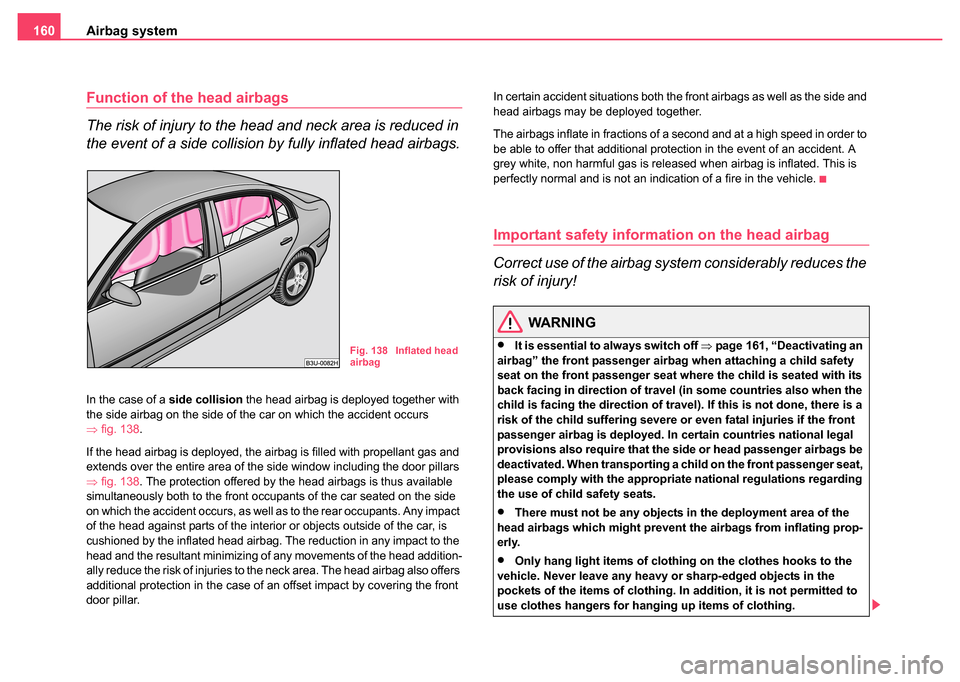
Airbag system
160
Function of the head airbags
The risk of injury to the head and neck area is reduced in
the event of a side collision by fully inflated head airbags.
In the case of a side collision the head airbag is deployed together with
the side airbag on the side of the car on which the accident occurs
⇒ fig. 138 .
If the head airbag is deployed, the airbag is filled with propellant gas and
extends over the entire area of the side window including the door pillars
⇒ fig. 138 . The protection offered by the head airbags is thus available
simultaneously both to the front occupants of the car seated on the side
on which the accident occurs, as well as to the rear occupants. Any impact
of the head against parts of the interior or objects outside of the car, is
cushioned by the inflated head airbag. The reduction in any impact to the
head and the resultant minimizing of any movements of the head addition-
ally reduce the risk of injuries to the neck area. The head airbag also offers
additional protection in the case of an offset impact by covering the front
door pillar. In certain accident situations both the front airbags as well as the side and
head airbags may be deployed together.
The airbags inflate in fractions of a second and at a high speed in order to
be able to offer that additional protection in the event of an accident. A
grey white, non harmful gas is released when airbag is inflated. This is
perfectly normal and is not an indication of a fire in the vehicle.
Important safety informati
on on the head airbag
Correct use of the airbag system considerably reduces the
risk of injury!
WARNING
•It is essential to always switch off ⇒ page 161, “Deactivating an
airbag” the front passenger airbag when attaching a child safety
seat on the front passenger seat where the child is seated with its
back facing in direction of travel (in some countries also when the
child is facing the direction of travel). If this is not done, there is a
risk of the child suffering severe or even fatal injuries if the front
passenger airbag is deployed. In certain countries national legal
provisions also require that the side or head passenger airbags be
deactivated. When transporting a child on the front passenger seat,
please comply with the appropriat e national regulations regarding
the use of child safety seats.
•There must not be any objects in the deployment area of the
head airbags which might prevent the airbags from inflating prop-
erly.
•Only hang light items of clothing on the clothes hooks to the
vehicle. Never leave any heavy or sharp-edged objects in the
pockets of the items of clothing. In addition, it is not permitted to
use clothes hangers for hanging up items of clothing.
Fig. 138 Inflated head
airbag
Page 162 of 270

Airbag system161
Using the systemSafetyDriving TipsGeneral MaintenanceBreakdown assistanceTechnical Data
•There must not be any other persons (e.g. children) or animals
between the car occupant and the deployment area of the head
airbag. In addition, none of the occupants should lean their head
out of the window when driving, or extend their arms and hands out
of the window.
•The sun visors must not be swivelled to the side windows into
the deployment area of the head airbags if any objects, such as
ball-point pens etc. are attached to them. This might result in inju-
ries to the occupants if the head airbag is deployed.
•Installing impermissible accessories in the area of the head
airbags may considerably impair the protection offered by the head
airbag in the event of it being deployed. When the deployed head
airbag is inflated, parts of the accessories fitted may in certain
circumstances be thrown into the interior of the car and cause inju-
ries to the occupants ⇒ page 233, “Accessories, changes and
replacement of parts”.
•Any work on the head airbag system including installing and
removing system components because of other repair work (e.g.
removing headliner) must only be carried out by a Škoda dealer.
Deactivating an airbag
Deactivating airbags
If any airbags have been deactivated, switch them on
again as soon as possible so that they are able to again
provide their proper protection.
There is the technical means installed within your vehicle to switch off the
front, side or head airbag (take out of commission).
This is why you should have the deactivation of the airbags carried out by
a Škoda dealer.
On vehicles equipped with the switch for deactivation of the airbags, you
can deactivate the front and side passenger airbag by means of this
switch ⇒page 162.
Deactivation of airbags is envisaged only for particular instances,
such as if
•Yo u m u s t i n exceptional cases use a child seat on the front
passenger seat where the child is seated with its back to the direction of
travel (in some countries this must be in the direction of travel due to other
legal regulations applying) ⇒page 164, “Important safety information on
using child safety seats”.
•you are not able to maintain the distance of at least 25 cm between
middle of steering wheel and chest, despite the driver seat being correctly
adjusted.
•special attachments are required in the area of the steering wheel
because of a physical disability.
•you have installed other seats (e.g. orthopaedic seats without side
airbags).
WARNING (continued)
Page 163 of 270

Airbag system
162
Monitoring the airbag system
The functionality of the airbag system is also monitored electronically,
when one airbag has been switched off
An airbag which has been switched off by a Škoda dealer using the
vehicle system tester:
•The warning light for the airbag system lights up for 3 seconds after
switching on the ignition and then flashes for 12 seconds afterwards in 2
second intervals.
Front passenger airbags switched off using the switch for front
passenger airbags* in stowage compartment on the front passenger
side:
•The airbag indicator light in the instrument cluster comes on for about
3 seconds each time the ignition is switched on.
•Switching off airbags is indicated in the middle of the dash panel by the
lighting up of the indicator light ⇒ page 162.
Note
Your Škoda dealer will be able to advise you whether national legislation
in your country allows airbags in your vehicle to be deactivated, and which
ones.
Switch for th e front seat passenger airbags*
The front and side passenger airbag is deactivated with the
switch.
Fig. 139 Storage
compartment: Switch
for the front seat
passenger airbags
Fig. 140 Indicator light
for a switched off front
seat passenger airbag
Page 164 of 270

Airbag system163
Using the systemSafetyDriving TipsGeneral MaintenanceBreakdown assistanceTechnical Data
Deactivating airbags
– Switch off the ignition.
– Turn the slot of the airbag switch using the master key in the
direction of the arrow to the position OFF ⇒ fig. 139. The slot
of the airbag switch must be located in the vertical position.
– Check whether the airbag indicator light
in the
middle of the dash panel lights up ⇒fig. 140 when the ignition
is turned on.
Switching on airbags
– Switch off the ignition.
– Turn the slot of the airbag switch using the master key in the direction of the arrow to the position ON ⇒ page 162, fig. 139.
The slot of the airbag switch must be located in the horizontal
position.
– Check whether the airbag indicator light
in the
middle of the dash panel lights up ⇒page 162, fig. 140 when
the ignition is turned on.
The airbags should only be switched off under exceptional circumstances
⇒ page 161.
Indicator light
(airbag switched off)
The airbag indicator light is located in the middle of the dash panel
⇒ page 162, fig. 140 .
If the airbags are switched on , the airbag indicator light comes on for a
few seconds after the ignition is switched on.
When the front and side passenger airbag is switched off, the indicator
light comes on after the ignition is switched on. There is a system fault present in the airbag switch off
⇒ if the indi-
cator light flashes. Please have the vehicle inspected without delay by
a Škoda dealer.
WARNING
•Only switch off the airbags when the ignition is switched off!
Otherwise a fault can arise on the airbag system and therefore
could cause the airbag to trigger.
•The driver is responsible for whether the airbags are switched
on or switched off.
•If the indicator light flashes:
− There is a risk of the front passenger airbag or the side
passenger airbag not being deployed in the event of an acci-
dent.
− There is the risk, if someone is sitting on the front passenger
seat, that the front passenger will suffer injury if the airbag is
suddenly deployed.
Page 165 of 270
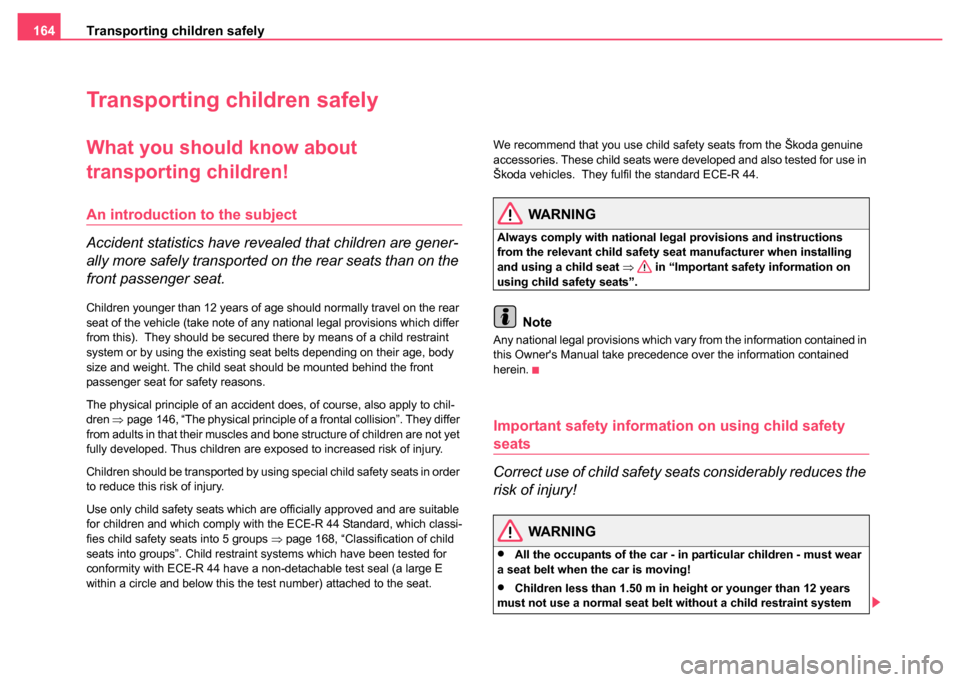
Transporting children safely
164
Transporting children safely
What you should know about
transporting children!
An introduction to the subject
Accident statistics have revealed that children are gener-
ally more safely transported on the rear seats than on the
front passenger seat.
Children younger than 12 years of age should normally travel on the rear
seat of the vehicle (take note of any national legal provisions which differ
from this). They should be secured there by means of a child restraint
system or by using the existing seat belts depending on their age, body
size and weight. The child seat should be mounted behind the front
passenger seat for safety reasons.
The physical principle of an accident does, of course, also apply to chil-
dren ⇒page 146, “The physical principle of a frontal collision”. They differ
from adults in that their muscles and bone structure of children are not yet
fully developed. Thus children are exposed to increased risk of injury.
Children should be transported by using special child safety seats in order
to reduce this risk of injury.
Use only child safety seats which are officially approved and are suitable
for children and which comply with the ECE-R 44 Standard, which classi-
fies child safety seats into 5 groups ⇒page 168, “Classification of child
seats into groups”. Child restraint systems which have been tested for
conformity with ECE-R 44 have a non-detachable test seal (a large E
within a circle and below this the test number) attached to the seat. We recommend that you use child safety seats from the Škoda genuine
accessories. These child seats were developed and also tested for use in
Škoda vehicles. They fulfil the standard ECE-R 44.
WARNING
Always comply with national le
gal provisions and instructions
from the relevant child safety seat manufacturer when installing
and using a child seat ⇒ in “Important safety information on
using child safety seats”.
Note
Any national legal provisions which vary from the information contained in
this Owner's Manual take precedence over the information contained
herein.
Important safety informati on on using child safety
seats
Correct use of child safety seats considerably reduces the
risk of injury!
WARNING
•All the occupants of the car - in particular children - must wear
a seat belt when the car is moving!
•Children less than 1.50 m in height or younger than 12 years
must not use a normal seat belt without a child restraint system